
The need for an LRT line in southeast Calgary has been under consideration since the mid-1980s as communities in that area developed quickly. Rapid transit was envisioned for the north as early as 1967, and Centre Street N has evolved into the busiest bus rapid transit (BRT) corridor in the city.
Planning for the Green Line as we know it today began in 2011. See what milestones, public open houses and engagement sessions helped shaped the timeline:
First groundbreaking for Green Line’s Public Gardens Initiative (August)
The redevelopment of George Moss Park in Ogden is a significant step towards creating inclusive and vibrant public spaces along the Green Line. This is the first of a minimum of six outdoor community spaces that will be located within 500 metres of future Green Line stations.
Construction begins on 78th Avenue Project in Ogden (July)
Following evaluation of the RFP, the Green Line Board selected Graham Construction to build the 78 Avenue Project. Before building the Ogden LRT station and tracks, the 78th Avenue Project will complete vehicle and pedestrian tunnels under the Canadian Pacific Kansas City Railway (CPKC) railway corridor to enhance mobility and pedestrian safety around the future Green Line LRT Ogden Station.
Development Partner selected (April)
Following a successful procurement, the Green Line Board happroved the Development Phase Agreement and selected Bow Transit Connectors (BTC) as Green Line’s Development Partner. This announcement launched the Development Phase, which allows for collaboration, design progression, and agreement on project costs, risks, and overall schedule between Green Line and BTC, before signing a Project Agreement.
Land acquired for Eau Claire Station (January)
The Green Line Board and City of Calgary reached an agreement in principle with Harvard Developments to acquire the land for the future underground station at Eau Claire. This station is both the temporary terminus for Phase 1 of the Green Line LRT, from Shepard to Eau Claire, and serves as the future connection between the north and south legs of Green Line.
Light Rail Vehicle (LRV) mock-up (November)
Green Line received a mock-up of its new low-floor LRV. The mock-up will be used to validate Green Line’s technical requirements and ensure accessibility, and will eventually become a training simulator for future transit operators.
Delivery Partner selected (November)
Following a Request for Proposals evaluation, CSIX Partners was selected as the Delivery Partner. They will supplement the Green Line team in support of delivering Phase 1 (Shepard to Eau Claire) across a range of project functions, including commercial management, technical support, project controls, and construction management.
Green Line hosts Business Information Session (November)
An information session was hosted to introduce Calgary’s local contractors, suppliers and trades to the two proponent teams competing to design, build and construct Phase 1 of the Green Line LRT.
Request for Proposals issued for Phase 1 (September)
The Request for Proposals (RFP) was released to select a proponent to design, construct and finance Phase 1, from Shepard to Eau Claire, of the Green Line LRT. The RFP was released to the two proponent teams, Bow Transit Connectors and City Link Partners, who were short-listed through the Request for Qualifications stage.
Two proponent teams selected (July)
Following the Request for Qualifications (RFQ) for construction of Phase 1, from Shepard to Eau Claire, the Green Line Board approved two proponent teams, Bow Transit Connectors and City Link Partners, to advance to the Request for Proposal (RFP) stage.
Request for Qualifications released for Phase 1 development (March)
Green Line released the Request for Qualifications (RFQ) for construction of Phase 1, from Shepard to Eau Claire. The RFQ creates a short-list of candidates, from which a Development Partner can be selected to build Phase 1 of the Green Line LRT.
Contract awarded for Light Rail Vehicles (LRVs) (November)
The Green Line Board and The City selected CAF (Construcciones y Auxiliar de Ferrocarriles) as the supplier of our new fleet of LRVs for the Green Line LRT Project. The contract includes 28 modern low floor LRVs.
New Green Line CEO (August)
The Green Line Board appointed Darshpreet Bhatti as CEO of the Green Line LRT project effective August 16, 2021.
Federal Government support announcement (July)
Prime Minister Justin Trudeau reconfirmed federal support of the Green Line LRT project and the redefined procurement strategy at an announcement in Calgary along with the Mayor and members of Calgary City Council.
Government of Alberta approves Green Line LRT project (June)
Following an extensive review of the overall Green Line LRT project, the Government of Alberta approved the redefined procurement strategy and federal funding business case that was submitted to the province on May 28, 2021.The Green Line will be constructed through a new phased approach, with the first phase building the LRT from Shepard to Eau Claire.
Segment 2 Functional Plans (May)
The updated Segment 2 Functional Plan was presented to the Green Line Committee on May 19, 2021 and was approved. The plan included:
Beltline and Downtown Utility Relocation Project (May)
The project to relocate utilities in east Beltline and Downtown started. This project will make way for the main alignment construction of the tunnel, track and stations.
Segment 2 Engagement (January to April)
A variety of virtual engagement opportunities were conducted to help inform functional planning for project areas in segment 2 (4 Street S.E. to 16 Avenue North):
Green Line Board (January)
The City announced the Green Line Board, comprised of nine members, who will govern, oversee and deliver the Green Line LRT project.
Updated Alignment engagement (January to April)
Stakeholders discussed challenges with the proposed Bow River tunnel and alignment changes. The Stage 1 alignment was updated to replace the tunnel with a bridge. The decision was made to construct Stage 1 in three segments:
Business Support Program (November)
Online engagement helped develop a Business Support Program. The goal is to help businesses and communities prepare for and manage the potential impacts of construction. A Business Insights Panel was recruited to advise on and share insights from the business community.
June 2020 – Council approved the updated Stage 1 alignment
July 2020 – Council approved the Green Line governance structure
November 2020 – The TOD Implementation Framework received the Outstanding Planning for Human Settlements/Plan Making from the Commonwealth Association of Planners
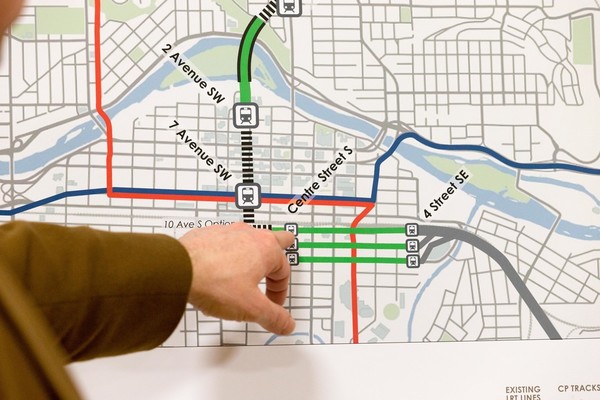
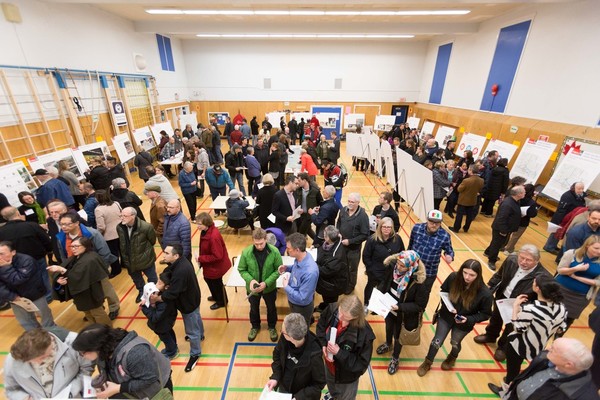
Public Gardens Scoping Report (April)
An informal Steering Committee helped develop a Public Gardens Scoping Report that sets a vision for
Council approved development of a master plan for six public garden projects. These projects were based on the historic railway gardens concept.
Transit Oriented Development (TOD) Implementation Strategy (December)
The TOD Implementation Strategy enables TOD to thrive in Calgary. It identified four key actions:
January 2019– Funding agreement signed by the Government of Canada, the Government of Alberta and The City of Calgary.
July 2019 – Council approved the contracting strategy.
July 2019 – Notice of Motion to form an informal Public Gardens Committee. They will explore a modernizing traditional Railway Gardens and the feasibility of using the Public Art budget to integrate art as part of the public gardens.
Green Line in My Community (GLIMC) engagement (January to February)
GLIMC open house and pop-up sessions gathered input on station designs:
May 2018 – Government of Canada announced $1.53B funding commitment
Green Line in My Community (GLIMC) engagement (March)
Citizens attended events for the north, southeast, City Centre and Beltline alignments and gave insight into:
Refinement engagement
Input gathered through GLIMC engagement was used to help refine various aspects of Green Line, like:
Beltline Alignment engagement (May)
Engagement sessions were held on four alignment options for Victoria Park. The transition to 10 Avenue S.E. was selected to connect the Beltline to the Ramsay/Inglewood station. This addressed traffic concerns and minimizes impacts to residential communities.
Green Line LRT report (May)
The Building the Core report established 126 Avenue S.E. to 16 Avenue N. as Stage 1. This met criteria like:
Green Line Urban Integration (GLUI) framework (June)
A 3-volume GLUI framework was developed that:
City Shaping Framework (June)
City Shaping is Layer 4 of the Green Line planning approach. The City Shaping framework outlined:
Framework for Transit Oriented Development (TOD) Implementation Strategy (June)
The TOD Implementation framework outlined the proposed approach and outputs for the strategy. Among the nine objectives was a City-wide perspective on TOD implementation that was adopted as part of The City’s TOD Program (presented to Council in 2019).
2017 – The Integrated Transportation and Land Use Planning approach was shared at conferences in Canada, United States and Singapore.
June 2017 – Council approved Green Line LRT alignment and stations (160 Avenue N. to Seton).
July 2017 – Government of Alberta announced $1.54B funding commitment
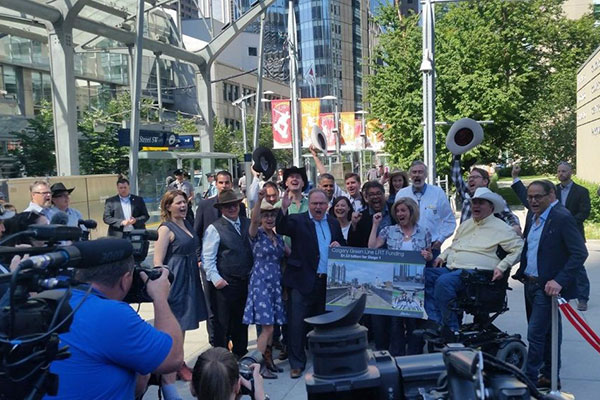
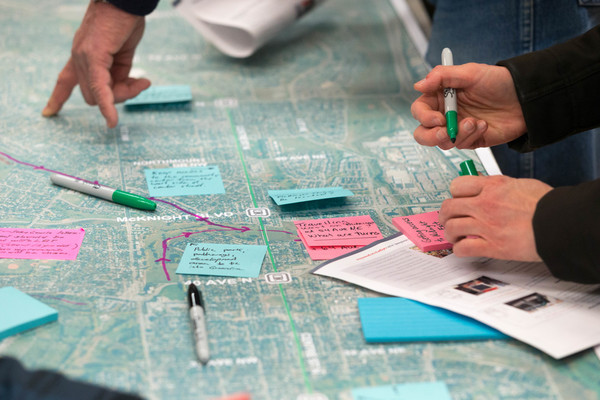
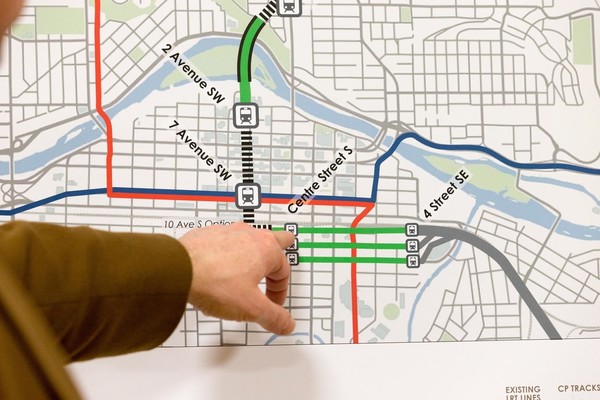
Centre City and Beltline engagement
Feedback was collected to evaluate the Centre City and Beltline routes. This helped City Council decide to build a tunnel through this section of the alignment. In December, route options were narrowed through the Beltline to the 12 Avenue S. corridor.
Transit Oriented Development (TOD) Background Research – North
Green Line reviewed City policies, North American TOD best practices and conducted a GIS analysis of existing conditions and land use, which was used to help prioritize site selection.
Transit Oriented Development (TOD) Market Analysis – North
Green Line estimated the long-term demand for different types of housing and office space. Implications for TOD options were identified along different parts of the corridor.
Inglewood & Ramsay Area Redevelopment Plans (February to April)
The engagement results from the Green Line S.E. charrettes in 2015 were used as a basis for the Area Redevelopment Plans (ARP) for the Inglewood/Ramsay and 26 Avenue station areas. A public open house was held on February 10, and an information café was held on April 28.
Refinement engagement – North (March to June)
Workshops were held in northern communities. Feedback showed how the Green Line could help
Transit Oriented Development (TOD) Charrettes – North (April to October)
Three charrettes were held around development of Station Area Concept Plans for the north alignment:
The concept plans were used to develop Station Area Plans, Local Area Plans and Area Redevelopment Plans.
Green Line Speaker Series (June to October)
Four sessions shared Green Line’s innovative approaches to:
Green Line Southeast Transitway Project – Public Information Sessions (January)
Three public information sessions were held for the Green Line Southeast Transitway Project. The purpose of these sessions was to inform citizens about the upcoming engineering and design work to be done, land use studies to be conducted, and outline how interested citizens can be involved in the process.
Transit Oriented Development (TOD) Charrettes – Southeast (June)
Three charrettes were held around TOD options and development concepts for five stations:
Citizen input helped clarify the scale and type of development for each station. Community issues and goals were worked into the conceptual designs, initial concepts and preferred development plan.
Green Line Southeast Public Engagement Workshop (June)
Local residents shared their concerns and desires for the station area regarding existing community connectivity and area improvements.
January 2015 - Council approved the route of the North Central LRT on Centre Street North
May 2015 – Notice of Motion to outline the project delivery model for the Green Line LRT
December 2015 - Notice of Motion for municipal commitment ($52 million for 10 years) to be extended to a 30-year period. The new total funding commitment would be $1.56 billion. This decision was based on the federal government pledge through the Public Transit Fund. It relied on a provincial government funding commitment that was confirmed in 2017.
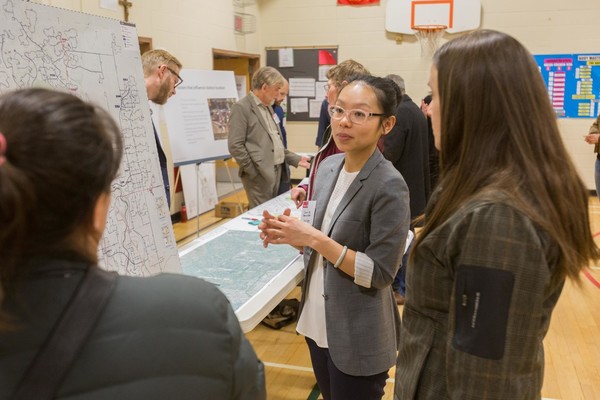
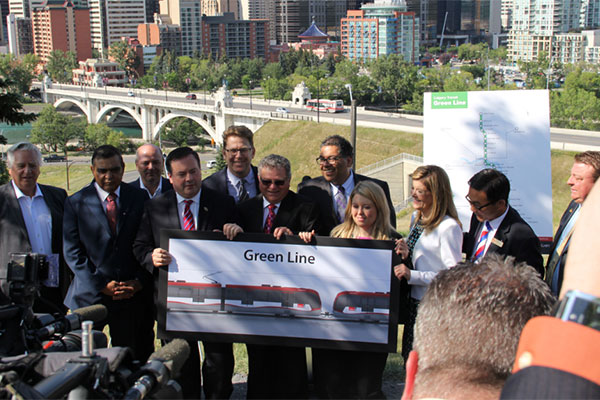
Alignment Development engagement
Citizens in southeast and north Calgary were targeted for feedback on potential routes. This led to refining the southeast route and choosing the Centre Street N. alignment.
Transit Oriented Development (TOD) Background Research – Southeast
Green Line reviewed City policies, North American TOD best practices and conducted a GIS analysis of existing conditions and land use, which was used to help prioritize site selection.
Transit Oriented Development (TOD) Market Analysis – Southeast
Green Line estimated the long-term demand for multi-family housing. Potential for new office space and TOD was identified along the corridor.
March 2014 – Notice of Motion to conduct TOD scoping and planning with the pre-design process and community-based visioning.
North Central Route planning engagement (June)
675 participants attended public engagement. They identified community traits and values based on feedback from 2011. They also reviewed alignment options and benefits of low floor Light Rail Vehicles (LRVs).
North Central LRT Alignment and Transit Oriented Development (TOD) (March)
The North Central Planning Study looked into land use planning for TOD from 2012 to 2014. It showed communities would be better served if the North Central LRT was more centrally located. This would provide more options for TOD than the Nose Creek Valley alignment.
Nose Creek, Edmonton Trail, Centre Street N. alignment engagement (May)
Around 2,150 Calgarians attended open houses. They explored the concept of an LRT line along Nose Creek, Edmonton Trail or Centre Street N. A new planning study determined a route based on a Centre Street N. or Edmonton Trail alignment.